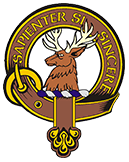History of Clan Davidson
This act was questioned in a letter to the Northern Chronicle, in which the writer pointed out that, while for a long period of years writers on Highland history had all pointed to Tulloch as the Chief, this must be taken as an error seeing that The Mackintosh was the only chief of Clan Chattan. In proof of this statement it was pointed out that in 1703 twenty persons named Dean alias Davidson had at Inverness signed a band of manrent declaring that they and their ancestors had been followers, dependents, and kinsmen to the lairds of Mackintosh, and were still in duty bound to own and maintain the claim, and to follow, assist, and defend the honorable person of Lachlan Mackintosh of that ilk as their true and lawful chieftain. A long correspondence followed pro and con, but it was pointed out by later writers that the acknowledgment of Mackintosh by twenty Davidsons as supreme head of the Clan Chattan confederacy in 1703 did not prevent the Davidson sept from possessing and following a chief of their own. As a matter of fact, history shows them to have had a chief at the battle of Invernahavon, and by all the laws of Highland genealogy the clansmen were fully entitled to meet and confirm the claim of their present leader and head.
Two other landed families of the name in the north are the Davidsons of Cantray and the Davidsons of Inchmarlo. The former are believed to have been settled on the lands of Cantray, an ancient property of the Dallases, for at least two hundred years. In 1767-8 the lands of Cantray and Croy were purchased by David Davidson, son of William Davidson and Agnes MacKercher, who afterwards added Clava to the estate. This laird married Mary, daughter of George Cuthbert of Castlehill, Sheriff-Substitute of Inverness, and is alluded to in the statistical account of 1842 as “a man of singular sagacity, of most active powers of mind, and practical good sense,” and as “a liberal-minded and fatherly landlord.” His son, another David, was knighted by King George III., and his grandson, Hugh Grogan, the fifth laird, was convener of the country of Inverness. His son, Hugh, as an officer of the Seaforth Highlanders, served through the Afghan War of 1880, for which he holds a medal.
Inchmarlo, again, was purchased in 1838 by Duncan Davidson, son of John Davidson of Tilliechetly and Desswood on Deeside. The laird of Inchmarlo was his grandson, Duncan, while his youngest son’s son is Francis Duncan Davidson, late captain in the Cameron Highlanders and latter owner of Desswood.
It should be added that Davidson of Tulloch is hereditary keeper of the royal castle of Dingwall.*
Among notable holders of the name of Davidson mention must be made of the redoubtable provost of Aberdeen, Sir Robert Davidson, who led the burghers of the city at the battle of Harlaw in 1411, and gallantly fell at their head. It is said to be his Armour which is still treasured in the vestibule of the City Chambers at Aberdeen, and when the great old church of St. Nicholas in that city was being repaired a generation ago his skeleton was recognized by a red cloth cap with which he had been buried.
Another notable clansman was John Davidson, Regent of St. Leonard’s College at St Andrews in the days of Queen Mary, and afterwards the minister of Liberton near Edinburgh, who quarreled with the Regent Morton, opposed the desire of James VI. to restore prelacy, excommunicated Montgomerie, Bishop of Glasgow, at the desire of the General Assembly in 1582, and was author of Memorials of His Time.
*Note: The Royal Castle of Dingwall should not be mistaken for Tulloch Castle – they are separate structures each with its own history.

